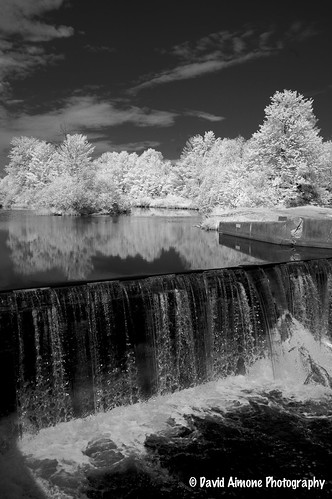I've been eyeing infrared photography as an "alternative" view of light and color. The problem is, infrared film photography has a steep learning curve. Metering for light exposure, processing, and other aspects are very difference. I've got enough on my plate (learning and practice-wise) on the film side.
At a recent workshop (see the previous post), the instructor, Elizabeth Opalenik, has worked a lot in infrared--both film and now digital. She mentioned a company that converts the sensor in digital cameras to the infrared spectrum. This essentially lets your camera see a different representation of color than your eyes can see. The photos come out color, but very different. However, digitally on the computer you can convert to black and white, yet still control tones in the photo selectively by the original colors in the photo. So, since skies are a different color than trees in infrared, you can adjust each separately. Blue skies tend to be darker, green leaves tend to be almost white.
I had a Nikon D40 body that I wasn't using much anymore, so I decided to do the conversion to a color infrared sensor filter. Now, the humble D40 can have a custom set white balance, which infrared really needs. But, if I shoot a RAW file (instead of JPEG), I can set the white balance on the computer before I edit.
So, here's an example of an infrared photograph as a RAW file:
Now, after adjusting the white balance on the computer to bring out more of the colors, it looks like this:
Finally, after switching the red and blue channels (and leaving the green channel as is), desaturating the photo, and then changing the strength of the underlying colors, this is one possible result:
Tuesday, July 26, 2011
Saturday, July 23, 2011
What a great workshop!
Attended a workshop given by Elizabeth Opalenik at the Center for Photography in Woodstock, NY. We worked with five models (four women and one gentleman) doing figure studies in the great Catskill outdoors. In addition to traditional work, we learned about the use of fabrics and their translucence dry and wet. We explored using motion to create drama, and we played around with a digital camera converted to infrared. In fact, in using infrared with models, I was inspired to have my older Nikon D40 converted to infrared.
Here are some photos from the workshop:
Here's one with a more infrared look:
An example of one with motion:
And an experiment with fabric:
I'll be putting this new knowledge to work with both digital and film. I'm so excited!
Here are some photos from the workshop:
Here's one with a more infrared look:
An example of one with motion:
And an experiment with fabric:
I'll be putting this new knowledge to work with both digital and film. I'm so excited!
Subscribe to:
Posts (Atom)








